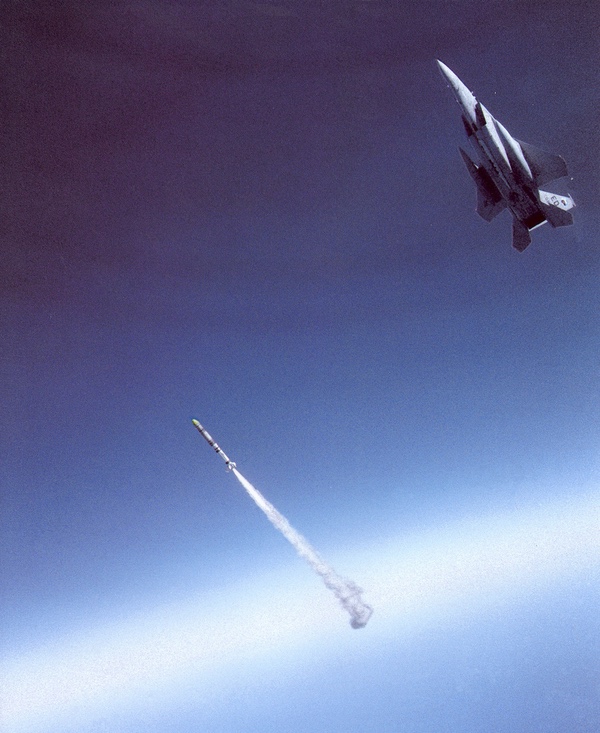Sword and shield: defending against an American anti-satellite weapon during the Cold Warby Dwayne A. Day
|
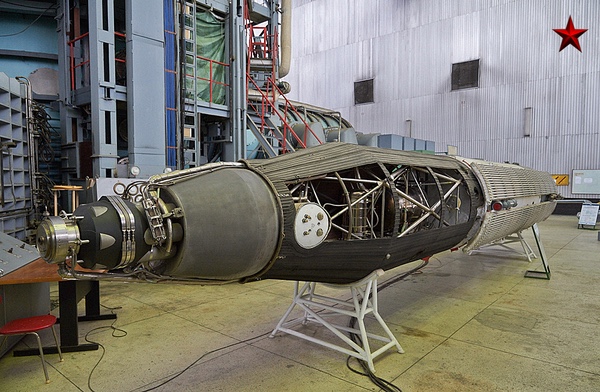 Mockup of a Soviet Radar Ocean Reconnaissance Satellite (RORSAT). Satellites of this type were launched throughout the 1970s and 1980s and used radar to detect ships at sea. They were a prime target for the American ASM-135 ASAT weapon. They were nuclear powered, and the reactor (at left) was a major heat source that could be detected by the missile's infrared seeker. (credit: TVZvezda) |
Dawn of a new ASAT
Although the Soviet Union had possessed a longstanding ASAT capability that was first tested in the latter 1960s and refined throughout the 1970s, the American ASAT program, which used a Thor rocket equipped with a nuclear warhead, had been shut down in the early 1970s because of its limited utility and effectiveness. By the middle of that decade, American national security officials were becoming increasingly concerned that Soviet satellites were placing US forces at risk, and a means of negating them during wartime was necessary. (See “To attack or deter? The role of anti-satellite weapons,” The Space Review, April 20, 2020; and “Blunt arrows: the limited utility of ASATs,” June 6, 2005.)
| The report offers interesting insights into the possible countermeasures that may still be valid today, nearly four decades later. |
By the early 1980s, the Reagan Administration started development of a new ASAT weapon that would be launched from an F-15 aircraft and was scheduled for deployment by 1987. Designated the Air Launched Maneuvering Vehicle and eventually given the formal designation ASM-135 (for Air-Space-Missile), it would use an infrared seeker to home in on its target and smash into it at high velocity, no warhead required. One of the primary targets for the weapon—indeed, one of the main justifications made in the mid-1970s for restarting the American ASAT program—was the Soviet Union’s nuclear-powered Radar Ocean Reconnaissance Satellite, or RORSAT. The RORSAT could scan the ocean horizon looking for American ships, although it could not identify them, thereby requiring information from electronic intelligence satellites, which were also potential targets for American ASATs. American intelligence analysts believed that the RORSAT was a significant threat to US Navy ships. The RORSAT’s reactor was hot, making it an easier target for an infrared seeker.
In September 1983, the CIA’s Directorate of Intelligence produced a report: “Soviet Satellite Defense Against the US Miniature Vehicle Antisatellite Weapon.” The report stated that “Our estimates of Soviet technological advances and of Soviet perceptions of the ASAT threat indicate a moderate likelihood that the Soviets will develop additional defensives—decoys, electronic countermeasures, and signature reduction—by the late 1990s.”
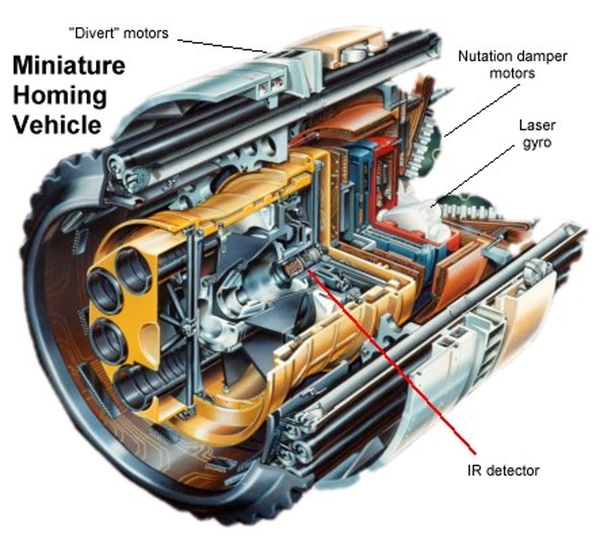 The Miniature Homing Vehicle, also referred to as the Air Launched Maneuvering Vehicle, was mounted at the nose of the ASM-135 ASAT weapon. The CIA noted in 1983 that a significant amount of information about this weapon was public knowledge and could be used by the Soviet Union to develop countermeasures. (credit: Sven’s Space Place) |
Even though it was still in development, by 1983 a great deal of information on the American weapon was publicly available. As the CIA report noted, “A U.S. Air Force contractor performed an analysis of the ALMV using only open-source material and was able to estimate the ALMV’s maneuver and altitude capabilities, possible attack geometries, the sensor’s field of view, and the correctable miss distance of the vehicle. Similar work performed by a Soviet analyst would indicate the effectiveness of potential defensive countermeasures.”
The report outlined the defensive options available to the Soviets:
Maneuvering
Most of the Soviet satellites that were targets for the ASM-135 were capable of maneuvering. Only one type of target, designated the ELINT-3 (for “electronic intelligence”), was not. But as the report noted, the satellites were designed for limited maneuvering only for operational purposes and maneuvering to defend themselves would quickly use up propellant. This could still present significant problems for attacking the satellite, however, “after a Soviet maneuver, it would take 20 to 60 minutes for the ALMV computer to receive and process maneuver information.” This “might force US mission planners to abort the attack.”
Replacement satellites
The report noted that the Soviets might also increase their number of satellites before and during a conflict. This would be expensive for them. Some satellites could also be stored in high orbits.
Attack on F-15 or airbase
The F-15s would be based in the United States and attacking them in the air would be difficult. However, their airbases could be attacked by submarine-launched ballistic missiles. “Special operational forces could also be used, but this is a much less likely alternative because of logistic problems.”
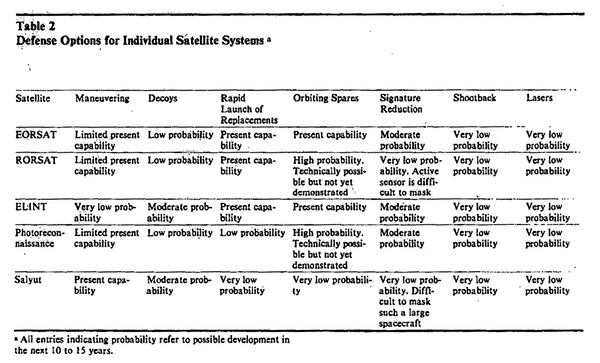 Declassified table of how different Soviet military and intelligence satellites might defend themselves from American ASAT attack. (credit: CIA report) |
Decoys
Decoys that radiate in the infrared were a possible way to defend against the American ASAT (flares are a common defense used by aircraft against heat-seeking missiles). However, they would add mass that might prohibit their use. The decoy would have to account for uncertainties in Soviet information about the American ASAT and its ability to process targeting data.
| The CIA did not believe that the Soviet Union could field effective countermeasures to the ASM-135 ASAT within a decade. |
Electronic countermeasures
Electronic countermeasures is the only section of the report that remains entirely deleted 38 years after it was written. American aircraft are currently equipped with systems designed to confuse the infrared seekers of missiles. Presumably, a similar system could have been developed for use on a satellite. Another possibility was somehow jamming the electronics of the missile.
Signature reduction
The report noted that the Soviets had experimented with aircraft radar reduction techniques as early as the 1950s. Their methods were difficult to implement, according to the report. They might be adopted for future systems. Another possible method was to reduce the infrared signature of the spacecraft by using different materials or construction techniques. “However, masking the infrared signature of the RORSAT’s nuclear reactor would be difficult,” the report stated.
Shootback
“The most effective way to counter the American ASAT weapon would be to destroy it in flight with either a laser or a missile. This shootback capability would significantly increase the probability of satellite survival, but neither of these shootback weapons is a near-term option because of major technological limitations.” A low-powered laser that could damage the ASAT’s sensor was considered the most likely shootback method.
Escort Satellites
The final defensive option identified by the report was an escort satellite that could defend a high-value satellite with lasers or nuclear or nonnuclear missiles. Defending low-altitude satellites would be difficult because there would be little time for warning, acquisition tracking, and engagement of the ASAT coming up to kill the target. “Because the Soviets do not possess the necessary technology, we believe they could not employ defensive escort satellites until the late 1990s.” The Soviet Union later developed the Polyus-Skif satellite equipped with a laser to destroy American Strategic Defense Initiative (SDI) satellites. But that would not have been suited to defending individual satellites against American ASAT attack.
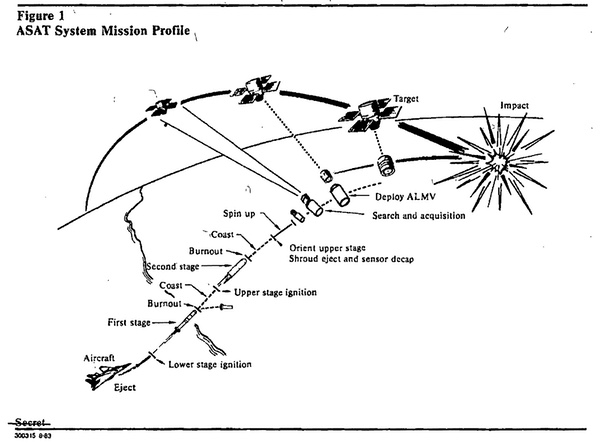 Declassified illustration of the way that the F-15-launched ASM-135 ASAT would attack its target. (credit: CIA report) |
ASATs as a continuing threat
The CIA did not believe that the Soviet Union could field effective countermeasures to the ASM-135 ASAT within a decade. The American ASAT was successfully tested only two years after the CIA report. But the weapon was highly controversial. It also had other limitations: it was expensive, and not popular with the Air Force which would have to spend a considerable amount of money on it. Soon after the test the program was officially canceled, although the weapon was maintained in a readiness condition in secret for another year before finally being permanently shelved. By the late 1980s, the Soviet Union stopped launching RORSATs, and not too much later the Cold War ended and the Soviet Union dissolved. ASAT weapons, however, have proliferated in the past decade, and presumably countermeasures are being studied by various space powers today.
Note: we are using a new commenting system, which may require you to create a new account.
